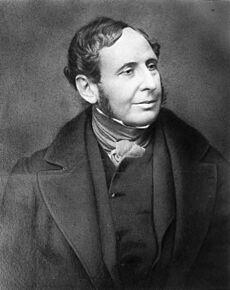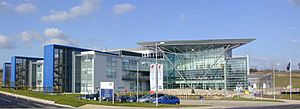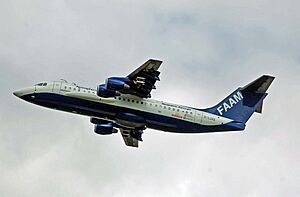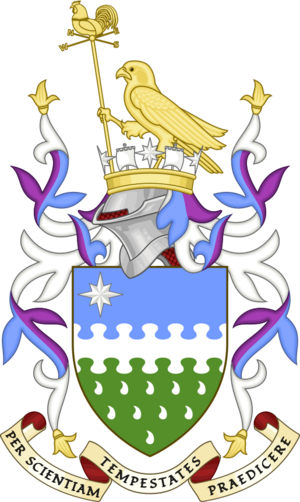Met Office facts for kids

Logo of the Met Office since 2000
|
|
| Agency overview | |
|---|---|
| Formed | 1 August 1854 |
| Jurisdiction | United Kingdom |
| Headquarters | Bracknell, Berkshire (before December 2003) Met Office Operations Centre, Exeter, Devon (since December 2003) |
| Motto | Per scientiam tempestates praedicere |
| Employees | 2,223 (March 2022) |
| Minister responsible |
|
| Deputy Minister responsible |
|
| Agency executives |
|
| Parent agency | Department for Science, Innovation and Technology |
The Met Office is the United Kingdom's national weather and climate service. It was officially called the Meteorological Office until November 2000. It is a special agency of the Department for Science, Innovation and Technology.
The Met Office is currently led by CEO Penelope Endersby. She became the Chief Executive in December 2018. She is the first woman to hold this important role. The Met Office creates weather predictions for all time periods. This includes daily weather forecasts and long-term climate change predictions.
Even though it's a UK government agency, the Met Office helps other governments. It supports the Scottish, Welsh, and Northern Ireland governments. They use Met Office information to prepare for bad weather. This helps them plan for extreme weather alerts. The Met Office has an office in Edinburgh, Scotland. It also has a forecasting centre in Aberdeen. These services help the Scottish Government with goals like dealing with climate change.
Contents
- History of the Met Office
- Met Office Locations
- Weather Forecasts and Warnings
- UK Weather Warnings
- How Weather Predictions are Made
- Flood Forecasting Centre
- Seasonal and Long-Range Forecasts
- Weather on TV
- World Area Forecast Centre
- Volcanic Ash Advisory Centre
- Air Quality Forecasts
- Predicting Climate for the Next Decade
- IPCC Connection
- Supercomputers for Weather Forecasting
- Customer Service Awards
- Weather Stations and Observations
- Meteorological Research and Aircraft Measurements
- Leaders of the Met Office
- Met Office Coat of Arms
- See also
History of the Met Office

The Met Office started on August 1, 1854. It was a small part of the Board of Trade. Vice Admiral Robert FitzRoy led it. Its first job was to help sailors.
A big storm in October 1859 caused a ship called the Royal Charter to sink. 459 lives were lost off the coast of Anglesey. This sad event led to the first gale warning service. FitzRoy set up 15 stations along the coast. These stations could give visual warnings to ships at sea.
The new electric telegraph helped send warnings quickly. It also helped create a network for observing weather. The Met Office began giving weather forecasts to newspapers in 1861. FitzRoy used special instruments called photo-barographs to help with this. These instruments recorded air pressure. Other weather instruments were also sent to stations. Forecasts stopped in May 1866 after FitzRoy's death. But they started again in April 1879.
Met Office and the Military
After the First World War, the Met Office joined the Air Ministry in 1919. This was because weather information was very important for planes. Many Met Office observation points were placed at RAF airfields. This is why many military airfields are still mentioned in weather reports today. In 1936, the Met Office split. The Royal Navy then got its own weather forecasting services.
In April 1990, the Met Office became a special agency of the Ministry of Defence. This meant it had to act more like a business.
Changes in Government Departments
The Met Office has moved between different government departments. On July 18, 2011, it became part of the Department for Business, Innovation and Skills. Then, on July 14, 2016, it joined the Department for Business, Energy and Industrial Strategy. This happened when two departments merged.
Even though it's no longer part of the Ministry of Defence, the Met Office still works closely with the military. It has offices at RAF and Army bases in the UK and overseas. The Mobile Met Unit (MMU) is a special group of Met Office staff. They are also RAF reservists. They go with military units during conflicts. They advise the armed forces about weather conditions for battles. This is especially important for the RAF.
Met Office Locations
In September 2003, the Met Office moved its main office. It moved from Bracknell in Berkshire to a new building in Exeter. This new building cost £80 million. It was officially opened on June 21, 2004. This was just before the Met Office's 150th birthday.
The Met Office has offices all over the world. This includes a forecasting centre in Aberdeen. It also has offices in Gibraltar and on the Falklands. Some Met Office staff work at universities. For example, there's MetOffice@Reading at the University of Reading. They also have staff at Army and Air Force bases. These are in the UK and other countries.
Weather Forecasts and Warnings
UK Weather Warnings
The Met Office gives out Severe Weather Warnings for the UK. These warnings are part of the National Severe Weather Warning Service. They warn people about weather that could affect travel. They also warn about weather that could be dangerous. In March 2008, the warning system got better. A new 'Advisory' stage was added.
The Met Office and Met Éireann (Ireland's weather service) started naming storms. This began in September 2015. It helps everyone use the same name for storms affecting the UK and Ireland. The first storm named was Abigail on November 10, 2015. In 2019, the Royal Netherlands Meteorological Institute (KNMI) joined them.
How Weather Predictions are Made
The Met Office's main job is to create forecast models. They collect information from weather satellites in space. They also use observations from Earth. This information is then processed using special computer models. These models are based on a software system called the unified model.
For UK customers, the main weather products are:
- 36-hour forecasts from the 1.5 km resolution UKV model. This covers the UK and nearby areas.
- 48-hour forecasts from the 12 km resolution NAE model. This covers Europe and the North Atlantic.
- 144-hour forecasts from the 25 km resolution global model.
The Met Office's Global Model forecast has been one of the best in the world. It has consistently ranked in the top 3 for global weather forecast performance. They also sell forecasts to other countries. Some forecasts are for military operations. Others are given free to developing countries in Africa. Sometimes, human forecasters adjust the computer forecasts.
Flood Forecasting Centre
The Flood Forecasting Centre (FFC) started in 2009. It is a joint project between the Environment Agency and the Met Office. Its job is to provide flood risk advice for England and Wales. Staff from both organizations work there. It is located at the Met Office headquarters in Exeter.
Scottish Flood Forecasting Service
In Scotland, a similar service is provided. It's called the Scottish Flood Forecasting Service. This is a joint effort between the Scottish Environment Protection Agency (SEPA) and the Met Office.
Seasonal and Long-Range Forecasts
The Met Office also makes forecasts for seasons and longer periods. They share these with customers and users worldwide. The Met Office was the first weather service to be recognized as a Global Producing Centre for long-range forecasts. This was by the World Meteorological Organisation. They continue to provide forecasts to the WMO.
Met Office research has made new discoveries in seasonal forecasting. This includes predictions for areas outside the tropics. They have shown their skill in predicting the North Atlantic Oscillation. This helps predict winter weather for Europe and North America.
Weather on TV
ITV uses Met Office data for its weather forecasts. They use the data to create animated weather symbols for ITV Weather.
The BBC used to use Met Office forecasts for all its weather reports. But on August 23, 2015, the BBC announced a change. They decided to use MeteoGroup, another weather provider. This was to get the best value for money for TV licence payers. However, the BBC still uses some Met Office data. This is especially for severe weather warnings and the Shipping Forecast. In July 2025, the BBC announced that it would work with the Met Office again in the future.
World Area Forecast Centre
The Met Office is one of only two World Area Forecast Centres (WAFCs). It is known as WAFC London. The other WAFC is in Kansas City, Missouri, and is called WAFC Washington. WAFC data is used every day to help planes fly safely. This is especially true for long flights. The data provides details about wind speed, air temperature, and clouds.
Volcanic Ash Advisory Centre
The Met Office also runs the London Volcanic Ash Advisory Centre (VAAC). This is part of its aviation forecast work. It provides forecasts to airlines about volcanic ash clouds. These clouds can be dangerous for planes. The London VAAC is one of nine worldwide. It covers the British Isles, the northeast Atlantic, and Iceland. All the active volcanoes in its area are in Iceland. The VAAC uses satellite images, seismic data, and observations. The NAME dispersion model helps predict where ash clouds will move. It forecasts their movement 6, 12, and 18 hours ahead.
Air Quality Forecasts
The Met Office also gives out air quality forecasts. They use a model called NAME. This model was first made to track nuclear accidents. But now it can predict how many different things move in the air. NAME is used for emergency responses. It is also used for regular air quality forecasting.
The forecast shows different pollutants and their health effects:
| Pollutant | Health Effects at High Level |
|---|---|
| Nitrogen dioxide Ozone Sulphur dioxide |
These gases can irritate your lungs. They can make lung diseases worse. |
| Particulates |
Tiny particles can go deep into your lungs. They can cause swelling. They can also make heart and lung diseases worse. |
Predicting Climate for the Next Decade
The Met Office helps gather climate predictions from around the world. This is part of its role as the World Meteorological Organisation's Lead Centre for Annual to Decadal Climate Prediction. These predictions are updated every year. A summary called the Global Annual to Decadal Climate Update is published each year.
IPCC Connection
Until 2001, the Met Office hosted a working group for the Intergovernmental Panel on Climate Change (IPCC). This group focused on climate science. In 2001, the group moved to the National Oceanic and Atmospheric Administration.
Supercomputers for Weather Forecasting
Making weather predictions needs a lot of computing power. The Met Office has had some of the most powerful supercomputers in the world. In November 1997, the Met Office supercomputer was ranked third globally.
| Year | Computer | Calculations per second | Global/Local Detail | Vertical Levels |
|---|---|---|---|---|
| 1959 | Ferranti Mercury | 3 kiloflops | (N.A./320 km) | 2 levels |
| 1965 | English Electric KDF9 | 50 kiloflops | (N.A./300 km) | 3 levels |
| 1972 | IBM System/360 195 | 4 megaflops | (300 km/100 km) | 10 levels |
| 1982 | CDC Cyber 205 | 200 megaflops | (150 km/75 km) | 15 levels |
| 1991 | Cray Y-MP C90/16 | 10 gigaflops | (90 km/17 km) | 19 levels |
| 1997 | Cray T3E 900/1200 | 430 gigaflops | (60 km/12 km) | 38 levels |
| 2004 | NEC SX-6 | 2.0 teraflops | (40 km/12 km) | 50 levels |
| 2006 | NEC SX-8 and SX-6 | 5.4 teraflops | (40 km/4 km) | 50 levels |
| 2009 | IBM Power6 | 140 teraflops | (17 km/1.5 km) | 70 levels |
| 2015 | Cray XC40 | 16 petaflops | (10 km/1.5 km) |
Customer Service Awards
Since 2012, the Met Office Contact Centre (called the Weather Desk) has been recognized. It has been part of the 'Top 50 Companies for Customer Service' program.
In 2015, the Met Office won several awards for its customer service:
- Rated 1st Overall for Combined Channels
- Most Improved Overall for Social Media
- Rated 2nd Overall for Call Service
- Rated 1st Overall for Email Service
- Best in Public Sector
- Best Extra Small Centre
Weather Stations and Observations
Weather stations collect information about the weather. Some stations are fully automatic. This means machines do all the work. Others are semi-automatic, with both machines and people. Some stations have people observing during the day. Then they switch to automatic at night. Many stations have sensors to detect current weather. They also use CCTV.
There is also a network of 'upper air' stations. These use special balloons called radiosondes. They measure weather high up in the atmosphere. The six main radiosonde stations in the UK are Camborne, Lerwick, Albemarle, Watnall, Castor Bay, and Herstmonceux.
Some stations report weather only at certain times. Others report continuously. This is often true for RAF and Army Air Corps stations. They have staff to provide weather information for military operations. The usual reporting schedule is once an hour. But automatic stations can be checked more often. Airfield stations report twice an hour. They also send special reports when the weather changes quickly. This helps airfield authorities know about conditions that might affect flights.
Some stations only report CLIMAT data. This includes things like maximum and minimum temperatures. It also includes total rainfall over a period. These are usually recorded at 0900 and 2100 hours daily. Often, people who don't work directly for the Met Office collect weather reports. This includes Air traffic control staff, coastguards, and university staff.
- Eskdalemuir Observatory
- Lerwick Observatory
- Penkridge weather station
- Prestatyn weather station
- Stonyhurst
- Sutton Bonington
- Wye weather station
- RAF Benson
- RAF Brize Norton weather station
- RAF Coningsby
- RAF Cottesmore
- RAF Cranwell weather station
- RAF Kinloss weather station
- RAF Leeming weather station
- RAF Leuchars weather station
- RAF Linton-on-Ouse weather station
- RAF Little Rissington weather station (supported by RAF Brize Norton)
- RAF Lossiemouth weather station
- RAF Lyneham weather station
- RAF Marham weather station
- RAF Northolt weather station 51.55 N 0.417 W
- RAF Odiham weather station
- RAF Shawbury
- RAF Waddington weather station
- Wattisham Flying Station weather station
- RAF Valley
- Middle Wallop Flying Station weather station
Meteorological Research and Aircraft Measurements
The Met Office has a Meteorological Research Unit (MRU) at Cardington. This unit studies a part of the atmosphere called the boundary layer. They use a special tethered balloon for their research. This balloon is kept in a small, portable hangar.
FAAM: Aircraft for Atmospheric Research
The Facility for Airborne Atmospheric Measurements (FAAM) is based at Cranfield Airport. It works with the Natural Environment Research Council.
FAAM provides aircraft for atmospheric research. This helps UK research groups with their studies around the world. Their main equipment is a special BAe 146 type 301 aircraft. Its registration is G-LUXE. This plane is used to measure many things in the atmosphere.
The FAAM aircraft helps with:
- Studying how light and heat move through clear and cloudy air.
- Measuring chemicals in the lower atmosphere (troposphere).
- Studying how clouds form and move.
- Understanding how medium-sized weather systems work.
- Studying the lowest part of the atmosphere and air movement.
- Checking ground-based instruments that measure from afar.
- Gathering information to check satellite data.
- Testing new satellite instruments.
- Research projects in the UK and other countries.
Leaders of the Met Office
- Sir William Napier Shaw 1905–1920
- Sir Graham Sutton 1954–1965
- Sir Basil John Mason 1965–1983
- Sir John Houghton 1983–1991
- Julian Hunt 1992–1997
- Peter Ewins 1997–2004
- David Rogers 2004–2005
- Mark Hutchinson 2005–2007
- John Hirst 2007–2014
- Rob Varley 2014–2018
- Penelope Endersby 2018–
Met Office Coat of Arms
See also
 In Spanish: Met Office para niños
In Spanish: Met Office para niños
- Climatic Research Unit email controversy
- Climate of the United Kingdom
- Climate change in the United Kingdom
- Burns' Day storm
- Eskdalemuir Observatory
- European Centre for Medium-Range Weather Forecasts
- Great Storm of 1987
- Met Éireann, the Irish meteorological service, which separated from the UK Met Office in 1936.
- North West Shelf Operational Oceanographic System
- Weather system naming in Europe





